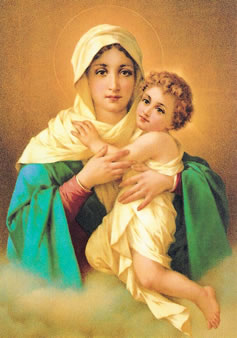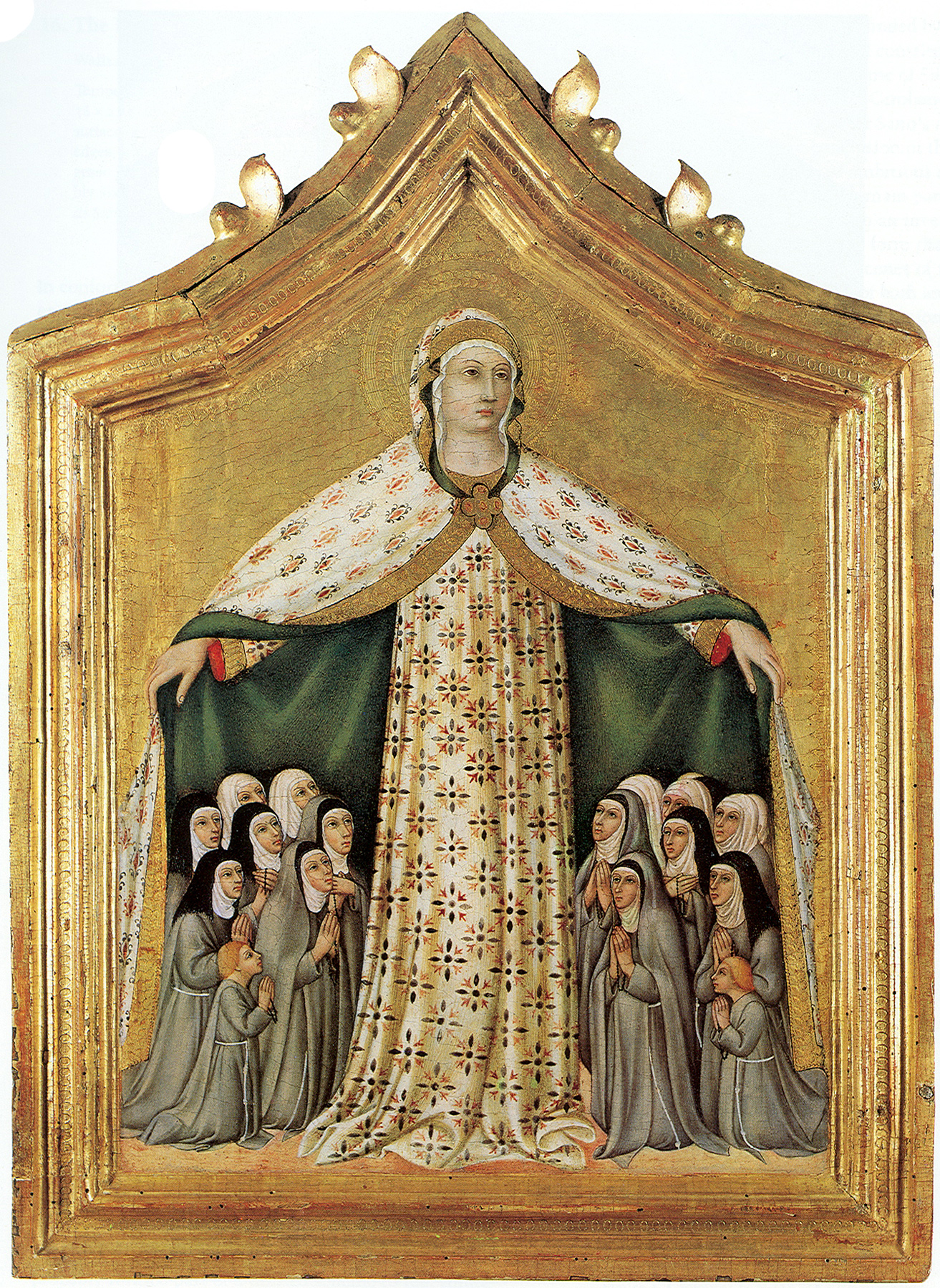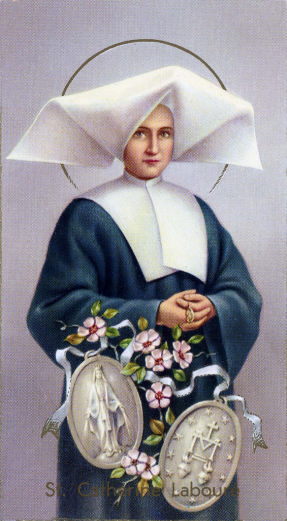|
Memorare
Memorare ("Remember, O Most Gracious Virgin Mary") is a Catholic prayer seeking the intercession of the Blessed Virgin Mary. It first appears as part of a longer 15th-century prayer, "Ad sanctitatis tuae pedes, dulcissima Virgo Maria." Memorare, from the Latin "Remember," is frequently misattributed to the 12th-century Cistercian monk Saint Bernard of Clairvaux, apparently due to confusion with its 17th-century popularizer, Father Claude Bernard, who stated that he learned it from his own father. Modern version The modern version is taken from that indulgenced by Pope Pius IX in 1846, Raccolta, #339 (S. C. Ind., Dec. 11, 1846; S. P. Ap., Sept. 8, 1935) Encr. Ind. #32: Memorare, O piissima Virgo Maria, a saeculo non esse auditum, quemquam ad tua currentem praesidia, tua implorantem auxilia, tua petentem suffragia, esse derelictum. Ego tali animatus confidentia, ad te, Virgo Virginum, Mater, curro, ad te venio, coram te gemens peccator assisto. Noli, Mater Verbi, verba mea de ... [...More Info...] [...Related Items...] OR: [Wikipedia] [Google] [Baidu] |
Claude Bernard (priest)
Father Claude Bernard (December 23, 1588 – March 23, 1641) was a French Roman Catholic priest who was active in ministry to prisoners and criminals, especially those condemned to death. Known as "le pauvre prêtre" ("the poor priest"), he is primarily remembered as the popularizer of the ''Memorare'', over 200,000 copies of which he distributed by leaflets printed in various languages. Life Claude Bernard was born at Dijon 23 December 1588. His father was a distinguished lawyer, and filled successively offices of honour and responsibility. Young Bernard was educated at the Jesuit College of Dole and was remarked for his brilliant imagination and wit. Pierre Le Camus, Bishop of Belley, urged him to enter the priesthood, but he declined, saying that he preferred the life of a poor gentleman to that of a poor priest. Shortly afterwards he went to Paris as a protégé of M. de Bellegarde, Governor of Bourgogne. For a while the social life of the capital attracted him; gradually, howeve ... [...More Info...] [...Related Items...] OR: [Wikipedia] [Google] [Baidu] |
Angelus
FIle:Jean-François Millet (II) 001.jpg, ''The Angelus (painting), The Angelus'' (1857–1859) by Jean-François Millet The Angelus (; Latin for "angel") is a Catholic devotion commemorating the Incarnation (Christianity), Incarnation of Jesus Christ, Christ. As with many Catholic prayers, the name ''Angelus'' is derived from its incipit—the first few words of the text: ("The Gabriel, Angel of the Lord declared unto Mary (mother of Jesus), Mary"). The devotion is practised by reciting as versicle and response three Biblical verses narrating the Sacred mysteries#Christian mysteries, mystery, alternating with the prayer "Hail Mary". The Angelus exemplifies a species of prayers called the "prayer of the devotee". The devotion is traditionally recited in Roman Catholic churches, convents, monasteries and by the faithful three times a day: in the morning, at noon and in the evening (usually just before or after Vespers). The devotion is also observed by some Western Rite Orth ... [...More Info...] [...Related Items...] OR: [Wikipedia] [Google] [Baidu] |
BVM(RC)
The veneration of Mary in the Catholic Church encompasses various devotions which include prayer, pious acts, visual arts, poetry, and music devoted to her. Popes have encouraged it, while also taking steps to reform some manifestations of it.For example, on March 12, 1969, Pope Paul VI reduced and rearranged the number of Marian feast days in ''Sanctitas clarior''. Several of his predecessors did similarly. The Holy See has insisted on the importance of distinguishing "true from false devotion, and authentic doctrine from its deformations by excess or defect". There are significantly more titles, feasts, and venerative Marian practices among Roman Catholics than in other Western Christian traditions. The term '' hyperdulia'' indicates the special veneration due to Mary, greater than the ordinary '' dulia'' for other saints, but utterly unlike the '' latria'' due only to God. Belief in the incarnation of God the Son through Mary is the basis for calling her the Mother of Go ... [...More Info...] [...Related Items...] OR: [Wikipedia] [Google] [Baidu] |
Indulgence
In the teaching of the Catholic Church, an indulgence (, from , 'permit') is "a way to reduce the amount of punishment one has to undergo for (forgiven) sins". The ''Catechism of the Catholic Church'' describes an indulgence as "a remission before God of the temporal punishment due to sins whose guilt has already been forgiven, which the faithful Christian who is duly disposed gains under certain prescribed conditions…" The recipient of an indulgence must perform an action to receive it. This is most often the saying (once, or many times) of a specified prayer, but may also include a pilgrimage, the visiting of a particular place (such as a shrine, Church (building), church, or cemetery), or the performance of specific good works. Indulgences were introduced to allow for the remission of the severe penances of the early church and granted at the intercession of Christians awaiting martyrdom or at least imprisoned for the faith.Cross, F. L., ed. ''The Oxford Dictionary of the ... [...More Info...] [...Related Items...] OR: [Wikipedia] [Google] [Baidu] |
Saint-Étienne-des-Grès, Paris
Saint-Étienne-des-Grès was a church and parish in Paris, France, formerly located in the Latin Quarter on the Rue Saint-Jacques. History Saint-Étienne-des-Grès was located on the Rue Saint-Jacques, on the site of the present Faculty of Law. It was one of the early centers of Christianity in Paris; it stood on a site said to be that of an oratory which was erected by St. Denis to St. Stephen. Its foundation dates to around the sixth century. Saint-Étienne was one of five Merovingian churches marking the road from Paris to Orleans. The original church was destroyed by the Vikings, but rebuilt in the 11th century. Canons were installed in 1045 to serve the church and pray for the king. It became a parish sometime before 1080, but the parish was absorbed by St. Benedict's between 1195 and 1205. The Chapter existed until 1790. The collegiate church was demolished in 1792. Notre Dame de Bonne Délivrance The church notably contained a Black Madonna, the ''Notre Dame de Bonne ... [...More Info...] [...Related Items...] OR: [Wikipedia] [Google] [Baidu] |
Francis De Sales
Francis de Sales, Congregation of the Oratory, C.O., Order of Minims, O.M. (; ; 21 August 156728 December 1622) was a Savoyard state, Savoyard Catholic prelate who served as Bishop of Geneva and is a saint of the Catholic Church. He became noted for his deep faith and his gentle approach to the religious divisions in his land resulting from the Protestant Reformation. He is known also for his writings on the topic of spiritual direction and spiritual formation, particularly the ''Introduction to the Devout Life'' and the ''Treatise on the Love of God''. Life Early years Francis de Sales was born two months premature on 21 August 1567 in the Château de Sales into the noble Sales family of the Duchy of Savoy, in what is today Thorens-Glières, Haute-Savoie, France. His father was François de Sales, Lord of Sales, Haute-Savoie, Sales, and Novel, and by marriage, de Boisy. His mother was a noblewoman, Françoise de Sionnaz, the only child of the prominent magistrate, Melchior d ... [...More Info...] [...Related Items...] OR: [Wikipedia] [Google] [Baidu] |
Catholic Church
The Catholic Church (), also known as the Roman Catholic Church, is the List of Christian denominations by number of members, largest Christian church, with 1.27 to 1.41 billion baptized Catholics Catholic Church by country, worldwide as of 2025. It is among the world's oldest and largest international institutions and has played a prominent role in the history and development of Western civilization.Gerald O'Collins, O'Collins, p. v (preface). The church consists of 24 Catholic particular churches and liturgical rites#Churches, ''sui iuris'' (autonomous) churches, including the Latin Church and 23 Eastern Catholic Churches, which comprise almost 3,500 dioceses and Eparchy, eparchies List of Catholic dioceses (structured view), around the world, each overseen by one or more Bishops in the Catholic Church, bishops. The pope, who is the bishop of Rome, is the Papal supremacy, chief pastor of the church. The core beliefs of Catholicism are found in the Nicene Creed. The ... [...More Info...] [...Related Items...] OR: [Wikipedia] [Google] [Baidu] |
Sub Tuum Praesidium
''Sub tuum præsidium'' (; ) is an ancient Christianity, Christian hymn and prayer dedicated to the Blessed Virgin Mary. The hymn enumerates her special election by God the Father and her motherhood of God the Son. It is one of the oldest known Mariology, Marian prayers and among the most ancient preserved hymns still currently in use. The Papyrus No. 470, containing a substantial portion of the prayer was dated initially to the 3rd or 4th century; later dated as late as the 9th century A.D. The dating of the Papyrus remains uncertain. Accordingly, the celebrated hymn is well attested within the Roman Catholic Church, the Eastern Orthodox Church and Oriental Orthodox Churches. Historicity The earliest text of this Marian hymn, hymn was found in a Coptic Orthodox Church of Alexandria, Coptic Orthodox Christmas liturgy. Rylands Papyrus 470 records the hymn in Koine Greek, Greek, and was dated to the 3rd century by papyrologist Edgar Lobel and by scholar Colin Henderson Roberts ... [...More Info...] [...Related Items...] OR: [Wikipedia] [Google] [Baidu] |
Enchiridion Indulgentiarum
''Indulgentiarum Doctrina'' is an apostolic constitution about indulgences issued by Pope Paul VI on 1 January 1967. It responds to suggestions made at the Second Vatican Council, it substantially revised the practical application of the traditional doctrine relating to indulgences.''The encyclopedia of Christianity, Volume 2'' by Erwin Fahlbusch 2001 , page 695 The title is taken from the opening words of the original Latin text. Content Background According to the Catechism of the Catholic Church, "The forgiveness of sin and restoration of communion with God entail the remission of the eternal punishment of sin, but temporal punishment of sin remains." Paul VI explained that sin brings punishments inflicted by God's sanctity and justice, which must be expiated either here on earth or else in the life to come. "These punishments are imposed by the just and merciful judgment of God for the purification of souls, the defense of the sanctity of the moral order and the restoration o ... [...More Info...] [...Related Items...] OR: [Wikipedia] [Google] [Baidu] |
Richard Challoner
Richard Challoner (29 September 1691 – 12 January 1781) was an English Catholic prelate who served as Vicar Apostolic of the London District during the greater part of the 18th century, and as Titular Bishop of Doberus. In 1738, he published a revision of the Douay–Rheims Bible. Early life Richard Challoner was born in Lewes, Sussex, on 29 September 1691. His father, also Richard Challoner, was married by licence granted on 17 January, either 1690 or 1691, to Grace (née Willard) at Ringmer, Sussex, on 10 February. After the death of his father, who was a Presbyterian winecooper (wine-barrel maker), his mother, now reduced to poverty, became housekeeper to the Catholic Gage family, at Firle, Sussex. It is not known for sure whether she was originally a Roman Catholic, or whether she subsequently became one under the influence of a Catholic household and surroundings. In any case, thus it came about that Richard was brought up as a Catholic, although he was not baptized ... [...More Info...] [...Related Items...] OR: [Wikipedia] [Google] [Baidu] |
Miraculous Medal
The Miraculous Medal (), also known as the Medal of Our Lady of Graces or the Medal of the Immaculate Conception, is a devotional medal, the design of which was originated by Catherine Labouré following her Marian apparition, apparitions of the Blessed Virgin MaryAnn Ball, 2003 Encyclopedia of Catholic Devotions and Practices'' p. 356 in the Chapel of Our Lady of the Miraculous Medal of Paris, France. The medal, a sacramental, was made by the goldsmith Adrien Vachette. According to the teaching of the Roman Catholic Church, sacramental, sacramentals, by the Church's prayer, prepare the faithful to receive grace and dispose them to cooperate with it. The prayer asking Mother Mary to pray for us which is, "O Mary, conceived without sin, pray for us who have recourse to thee", appears on the front of the medal. Background Catherine Labouré stated that on July 18, 1830, the eve of the feast of Saint Vincent de Paul, she woke up after hearing the voice of a child calling her and ... [...More Info...] [...Related Items...] OR: [Wikipedia] [Google] [Baidu] |






